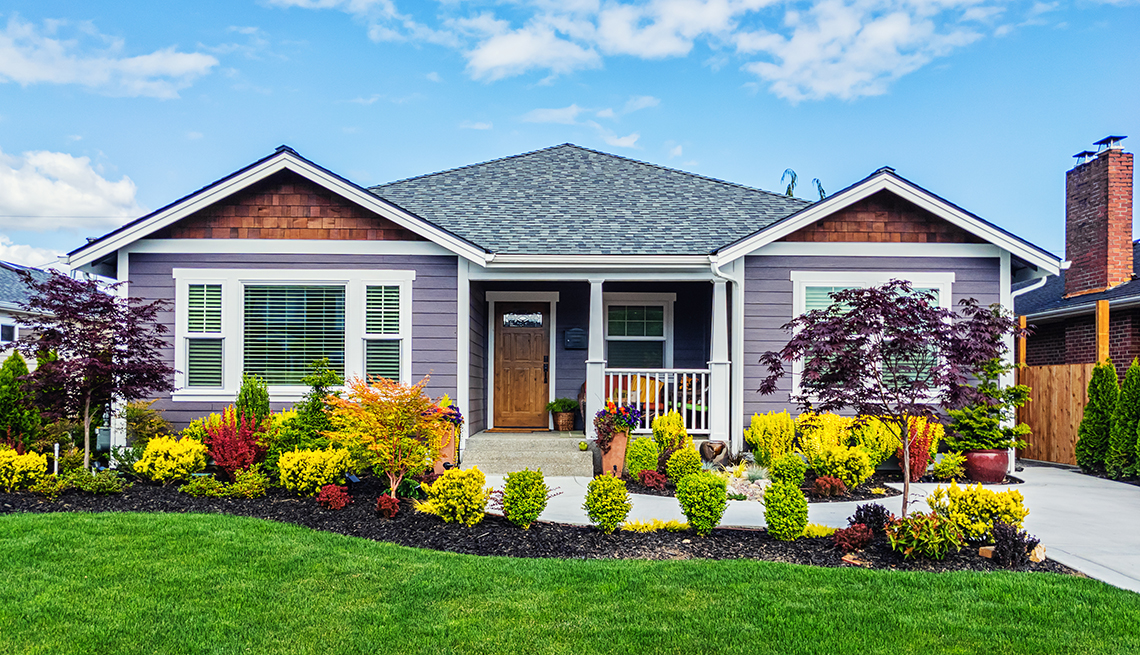
- Select a language for the TTS:
- UK English Female
- UK English Male
- US English Female
- US English Male
- Australian Female
- Australian Male
- Language selected: (auto detect) - EN
Play all audios:
13. ADD A WALKWAY THAT WOWS … Tired of the traditional concrete walkway that leads to your front door? Consider giving it a style upgrade with pavers — stone, brick or block that’s used to
cover a surface. They come in a variety of styles, from traditional cobblestones to more sleek, contemporary tiles. “Pavers are a great way to increase curb appeal, compared to poured
concrete, because the variety of textures and colors that are available is almost infinite,” says Joe Raboine, director of residential hardscapes with Belgard, a leading U.S. paver
manufacturer. You can hire an installer or do the job yourself, thanks to a DIY line of Belgard pavers available at home-improvement stores. “Redoing a walkway is the best DIY project when
it comes to pavers, since it typically involves a manageable, smaller space,” Raboine says. 14. … AND KEEP IT WEED-FREE After you update your walkway, or if you need to just clean up the
current one, keep weeds away by sealing the cracks. First kill the weeds and then add cement crack filler, an inexpensive and easy way to prevent weeds. There are many products available in
stores and online to fill in cracks permanently. Getty Images GIVE YOUR YARD SOME LOVE 15. LISTEN TO YOUR WEEDS Speaking of weeds, these “opportunistic plants” are a response to a
specific growing condition due to scalping — when you set your mower to a height level that’s lower than what’s recommended and it sends grass into shock. Look at the types of weeds you keep
seeing to determine your next steps. If you’re seeing lots of crabgrass, you probably also have poor soil and scalped turf, so raise the height of your mower and consider looking into
adding nutrients. Creeping Charlie? Too much shade, so overseed with shade-tolerant grass seed. Knotweed is likely due to compacted or heavy soil, so aerate in the fall and spring, or add
pavers for a walkway. White clover typically means the fertility of your soil is low. It’s best to let grass grow a little longer and to water deeply but less often — which will also help
crowd out the weeds. Pull them out and add grass seed, watering shallowly twice a day until established. Looking for an environmentally friendly way to kill dandelions? Try spraying them
with vinegar or pour boiling water on them. 16. CHECK YOUR SOIL If you’re doing everything by the book and your front yard still looks abysmal, it may be time to get scientific and check
your soil pH (level of acidity). If it’s too high, iron is less available, and if it’s too low, it can be toxic for plants. Many state cooperative extension service offices offer soil
testing, and you can also buy home kits online and at big-box stores — though the readings will likely not be as accurate as ones taken by an extension service. Once you have your results,
you can learn what kind of fertilizer (nitrogen, phosphorus or potassium) is needed to get your soil back in good health. 17. REFRESH YOUR LANDSCAPING Refreshing or redesigning your
landscape can add immediate curb appeal and real value to your home. “An overall landscape upgrade — including shrubs, mulching and a paver walkway — will cost around $5,000, but homeowners
can expect to recoup about 80 percent of the costs,” Raboine says. Homes with professionally landscaped front lawns can sell for 15 to 20 percent more than homes with less attractive
landscapes, according to the American Society of Landscape Architects. So, does your home call for a lavish English garden or a more minimalistic plant approach? When it comes to
landscaping, there’s no single right answer — and you can even mix elements of multiple styles, says Kevin Lenhart, design director and landscape architect at Yardzen, an online landscape
design service. Just remember to make your “design choice, whatever style it is, look intentional, professional and cohesive,” Lenhart adds. Or plant a tree or two. In a few years you’ll
have some nice shade. 18. PICK THE BEST PLANTS With certain areas of the country facing continuing drought conditions, there’s a growing movement to replace grass and other water-hogging
front yard plants with more drought-resistant alternatives. “We’re seeing a 66 percent increase in client requests for lawn removal,” Lenhart says. Even if you’re not ready to let go of your
traditional turf, you can promote water conservation by choosing native and low-maintenance landscape plants that are well adapted to your climate. “Pick the right plant for the right
place. That’s the motto,” Lenhart adds. If you’re mindful of growing patterns, the result can lead to a front yard that stands out and is a pollinator haven. Landscape architects and
designers can give professional advice on the best plants to add based on your desires, and local nurseries typically have a native plant section to choose from as well. 19. PRUNE
OVERGROWTH It’s hard for your home’s intrinsic charm to shine if it’s covered up by overgrown trees, shrubs or bushes. Borrow, rent or buy a pair of sharp handheld pruners or electric hedge
trimmers and get to work trimming excess limbs and branches. Generally, the best time to do deeper pruning is during the winter, but this can vary from species to species. Trimming your
plants to a manageable size so that they are no longer blocking front windows, doors and walkways will help your home feel more welcoming and less fortress like. 20. ADD A SMALL FENCE
Another way to keep the front yard looking tidy (or to keep dogs from messing up your landscape) is to install a small fence. But before you add the picturesque white picket or classic black
metal (or whatever iteration) fence, look up your city and county regulations for height and other requirements. If it separates your plot from your neighbor’s, it’s also recommended you
get their buy-in, and in some cases they may even help pay for part of it. 21. NIX MULCH CREEP If your mulch or landscaping gravel moves or washes away in the rain, install landscape edging
or pavers to clearly define the edges of your landscape beds and to help keep ground cover materials from spilling into the lawn or onto walkways. If small bits of mulch or gravel still
escape after rains or strong winds, consider trying a product like mulch glue, an outdoor adhesive that keeps mulch, pine straw, gravel, sand, dirt and other ground cover in place. 22.
REFRESH YOUR EXISTING MULCH Now that you’ve got your mulch staying in place, you might notice it needs a refresh. Many companies now sell easy-to-spray mulch dyes that typically become
colorfast in a few hours. Make sure to wear old clothes and to move away any pavers or other items that could get stained. 23. TRY A NEW MOWING PATTERN Keep your grass well-trimmed and, for
an extra wow factor, mow in a circle, spiral or stripes, based on the size and shape of your yard. Some people go as far as using a lawn roller to force the blades of grass down in one
direction in order to create a clean, stripy finish. 24. ADD CLEAN LINES Make your lawn look professionally manicured by using a trimmer or edger. Edging creates a neat cut line and
prevents the grass from growing onto the sidewalk. You can also use it to neaten up the space between grass and mulch and to create clean lines. 25. GROW GRASS FOR YOUR AREA Tall fescue or
zoysia? How about St. Augustine or Bermuda? Kentucky bluegrass or buffalo grass? Each region has grasses that will grow better in its zone, and seed companies are consistently developing
grasses that tout greater resilience and less maintenance. Typically, your local big-box garden center will sell grasses meant for your area and a few other varietals. But do your research
and consider seed strains that are already growing well in your yard. 26. FURNISH A FOCAL POINT Give passersby something to notice when they glance your home’s way — whether it’s an
attractive flowering tree, a front courtyard seating area or an eye-catching fountain or sculptural piece. “The right focal element is an expert way to add a bit of personality to your front
yard,” says Cassi Hallam, chief marketing officer at System Pavers, a California-based outdoor living design and installation company. “When it comes to your focal point, don’t be afraid to
go big,” Hallam adds. “Scale the element to fit the yard. If it’s too small, it’ll just add visual clutter. You want it to be big enough to hold its own. Frame it, flaunt it. Make the most
of your focal element, and design the bulk of your yard around it.” 27. INSTALL WINDOW BOXES If the style of your home can accommodate them — think Cape Cod, cottage, Craftsman or even
mid-century ranch — add window boxes to your front windows for an instant charm upgrade. Fill them with a mix of annuals such as begonias, impatiens, petunias or vinca, which grow only
around 8 to 12 inches tall, so they won’t block windows, Feathers says. To maximize the cuteness factor, she suggests including trailing ivy or other hanging greenery to add softness as well
as visual texture.




:max_bytes(150000):strip_icc():focal(942x0:944x2)/brendan-dassey-2000-3d31e61c78c441689637efd5acd76e49.jpg)

